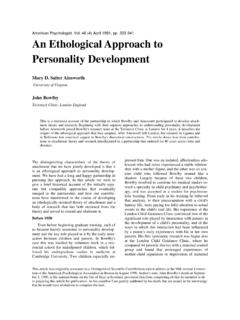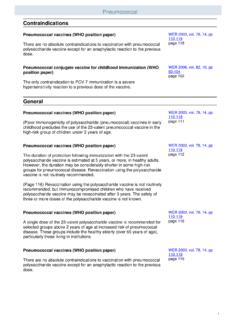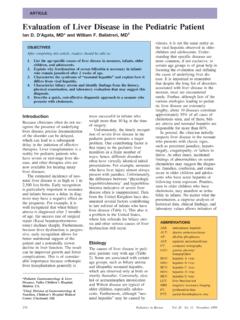Transcription of Prevention of Rotavirus Gastroenteritis Among …
1 Department of health and human servicesCenters for Disease Control and PreventionRecommendations and Reports February 6, 2009 / Vol. 58 / No. RR-2 Morbidity and Mortality Weekly of Rotavirus Gastroenteritis Among Infants and ChildrenRecommendations of the Advisory Committee on Immunization Practices (ACIP) MMWR Editorial BoardWilliam L. Roper, MD, MPH, Chapel Hill, NC, ChairmanVirginia A. Caine, MD, Indianapolis, INDavid W. Fleming, MD, Seattle, WAWilliam E. Halperin, MD, DrPH, MPH, Newark, NJMargaret A. Hamburg, MD, Washington, DCKing K. Holmes, MD, PhD, Seattle, WADeborah Holtzman, PhD, Atlanta, GAJohn K. Iglehart, Bethesda, MDDennis G. Maki, MD, Madison, WISue Mallonee, MPH, Oklahoma City, OKPatricia Quinlisk, MD, MPH, Des Moines, IAPatrick L. Remington, MD, MPH, Madison, WIBarbara K. Rimer, DrPH, Chapel Hill, NCJohn V. Rullan, MD, MPH, San Juan, PRWilliam Schaffner, MD, Nashville, TNAnne Schuchat, MD, Atlanta, GADixie E.
2 Snider, MD, MPH, Atlanta, GAJohn W. Ward, MD, Atlanta, GAThe MMWR series of publications is published by the Coordinating Center for Health Information and Service, Centers for Disease Control and Prevention (CDC), Department of Health and Human Services, Atlanta, GA Citation: Centers for Disease Control and Prevention . [Title]. MMWR 2009;58(No. RR-#):[inclusive page numbers].Centers for Disease Control and PreventionRichard E. Besser, MD(Acting) DirectorTanja Popovic, MD, PhDChief Science OfficerJames W. Stephens, PhDAssociate Director for ScienceSteven L. Solomon, MDDirector, Coordinating Center for Health Information and ServiceJay M. Bernhardt, PhD, MPHD irector, National Center for Health MarketingKatherine L. Daniel, PhDDeputy Director, National Center for Health MarketingEditorial and Production StaffFrederic E. Shaw, MD, JDEditor, MMWR SeriesSusan F.
3 Davis, MD(Acting) Assistant Editor, MMWR SeriesRobert A. Gunn, MD, MPHA ssociate Editor, MMWR SeriesTeresa F. RutledgeManaging Editor, MMWR SeriesDavid C. Johnson(Acting) Lead Technical Writer-EditorJeffrey D. Sokolow, MAProject EditorMartha F. BoydLead Visual Information SpecialistMalbea A. LaPeteStephen R. SpriggsVisual Information SpecialistsKim L. Bright, MBAQ uang M. Doan, MBAP hyllis H. KingInformation Technology SpecialistsContEntSIntroduction ..1 Background ..2 Rotavirus Vaccines ..4 Methodology ..4 Pentavalent Human-Bovine Reassortant Rotavirus Vaccine (RotaTeq [RV5]) ..4 Monovalent Human Rotavirus Vaccine (Rotarix [RV1]) ..12 Recommendations for the Use of Rotavirus Vaccine ..16 References ..21On the cover: Negative-stain electron micrograph of Rotavirus A. Courtesy of Charles D. Humphrey, 58 / RR-2 Recommendations and Reports 1 IntroductionRotavirus is the most common cause of severe Gastroenteritis in infants and young children worldwide.
4 Rotavirus causes approximately half a million deaths each year Among children aged <5 years, with >80% of deaths occurring in developing countries (1). In the United States during the prevaccine era, Rotavirus Gastroenteritis resulted in relatively few childhood deaths (approximately 20 60 deaths per year Among children aged <5 years) (2 5). However, before initiation of the rota-virus vaccination program in 2006, nearly every child in the United States was infected with Rotavirus by age 5 years; the majority had Gastroenteritis , resulting annually during the 1990s and early 2000s in approximately 410,000 physician Prevention of Rotavirus Gastroenteritis Among Infants and ChildrenRecommendations of the Advisory Committee on Immunization Practices (ACIP)Prepared byMargaret M. Cortese, MDUmesh D. Parashar, MBBS, MPHD ivision of Viral Diseases, National Center for Immunization and Respiratory DiseasesSummaryRotavirus is the most common cause of severe Gastroenteritis in infants and young children worldwide.
5 Before initiation of the Rotavirus vaccination program in the United States in 2006, approximately 80% of children had Rotavirus gastroenteri-tis by age 5 years. Each year during the 1990s and early 2000s, Rotavirus resulted in approximately 410,000 physician visits, 205,000 272,000 emergency department visits, and 55,000 70,000 hospitalizations Among infants and children , with total annual direct and indirect costs of approximately $1 billion. In February 2006, a live, oral, human-bovine reassortant Rotavirus vaccine (RotaTeq [RV5]) was licensed as a 3-dose series for use Among infants for the Prevention of Rotavirus Gastroenteritis , and the Advisory Committee on Immunization Practices (ACIP) recommended routine use of RV5 Among infants (CDC. Prevention of Rotavirus Gastroenteritis Among infants and children : recommendations of the Advisory Committee on Immunization Practices [ACIP].)
6 MMWR 2006;55[No. RR-12]). In April 2008, a live, oral, human attenuated Rotavirus vaccine (Rotarix [RV1]) was licensed as a 2-dose series for use Among infants, and in June 2008, ACIP updated its rotavi-rus vaccine recommendations to include use of RV1. This report updates and replaces the 2006 ACIP statement for Prevention of Rotavirus Gastroenteritis . ACIP recommends routine vaccination of infants with Rotavirus vaccine. RV5 and RV1 differ in composition and schedule of administration. RV5 is to be administered orally in a 3-dose series, with doses administered at ages 2, 4, and 6 months. RV1 is to be administered orally in a 2-dose series, with doses administered at ages 2 and 4 months. ACIP does not express a preference for either RV5 or RV1. The recommendations in this report also address the maximum ages for doses, contraindications, precautions, and special situations for the administration of Rotavirus , 205,000 272,000 emergency department (ED) visits, 55,000 70,000 hospitalizations, and total annual direct and indirect costs of approximately $1 billion (5 9) (Figure 1).
7 This report presents the recommendations of the Advisory Committee on Immunization Practices (ACIP) for use of two The material in this report originated in the National Center for Immunization and Respiratory Diseases, Anne Schuchat, MD, Director, and the Division of Viral Diseases, Larry Anderson, MD, preparer: Margaret M. Cortese, MD, National Center for Immunization and Respiratory Diseases, CDC, 1600 Clifton Rd., NE, MS A-47, Atlanta GA 30333. Telephone: 404-639-1929; Fax: 404-639-8665; E-mail: 1. Estimated number of annual deaths, hospitaliza-tions, emergency department visits, and episodes of Rotavirus Gastroenteritis Among children aged <5 years before introduc-tion of Rotavirus vaccine United States55,000 70,000 hospitalizations20 60 deaths205,000 272,000 emergencydepartment visits and 410,000outpatient/office million episodes2 MMWR February 6, 2009rotavirus vaccines Among infants: RotaTeq (RV5) (Merck and Company, Whitehouse Station, New Jersey), which was licensed by the Food and Drug Administration (FDA) in February 2006 (10) and Rotarix (RV1) (GlaxoSmithKline [GSK] Biologicals, Rixensart, Belgium), which was licensed by FDA in April 2008 (11).
8 This report updates and replaces the 2006 ACIP statement for Prevention of Rotavirus gastro-enteritis (12).BackgroundClinical and Epidemiologic Features of Rotavirus Disease in the Prevaccine EraIn the prevaccine era, Rotavirus infected almost all children by age 5 years; severe dehydrating Gastroenteritis caused by rota-virus occurred primarily Among children aged 4 23 months (13 15). Rotavirus infects the proximal small intestine, where it elaborates an enterotoxin and destroys the epithelial surface, resulting in blunted villi, extensive damage, and shedding of massive quantities of virus in stool (13). The estimated incu-bation period for Rotavirus diarrheal illness is <48 hours (16). Under experimental conditions, adults who became ill had symptoms 1 4 days after receiving Rotavirus orally (17,18). The clinical spectrum of Rotavirus illness in children ranges from mild, watery diarrhea of limited duration to severe diar-rhea with vomiting and fever than can result in dehydration with shock, electrolyte imbalance, and death (19).
9 The illness usually begins with acute onset of fever and vomiting, followed 24 48 hours later by frequent, watery stools (20,21). Up to one third of children with Rotavirus illness have a temperature of >102 F (>39 C) (22,23). Vomiting usually lasts <24 hours; other gastrointestinal symptoms generally resolve in 3 7 days. Rotavirus protein and ribonucleic acid (RNA) have been detected in blood, organs, and cerebrospinal fluid, but the clinical implications of these findings are not clear (20,24).Rotaviruses are shed in high concentrations ( , 1012 virus particles per gram of stool during the acute illness) in the stools of infected children before and several days after clinical disease (25). Rotavirus is transmitted primarily by the fecal-oral route, both through close person-to-person contact and through fomites (26). Very few infectious virions are needed to cause disease in susceptible hosts (25).
10 Spread is common within families. Of adult contacts of infected children , 30% 50% become infected, although infections in adults often are asymptomatic because of immunity from previous exposure (27 29). Transmission of Rotavirus through contaminated water or food is likely to be rare (30,31). Transmission through airborne droplets also has been hypothesized but remains unproven (21,30,32).In the United States, Rotavirus causes winter seasonal peaks of Gastroenteritis , with activity beginning usually in the southwestern states during December January, moving across the country, and ending in the northeastern states in April May (33 35). Rotavirus might account for up to 10% of Gastroenteritis episodes Among children aged <5 years (36). Infants and children with Rotavirus Gastroenteritis are likely to have more severe symptoms than those with nonrotavirus Gastroenteritis (22,23,37,38).














